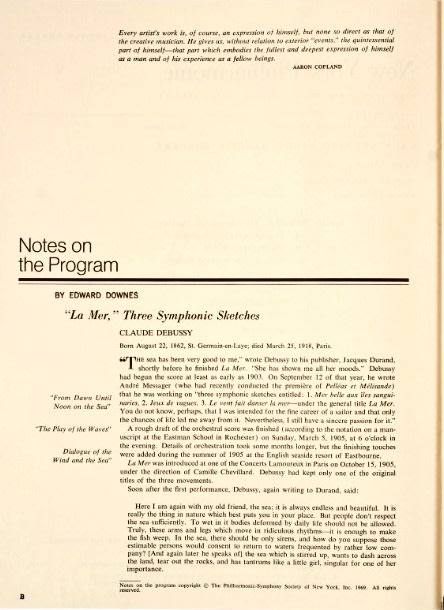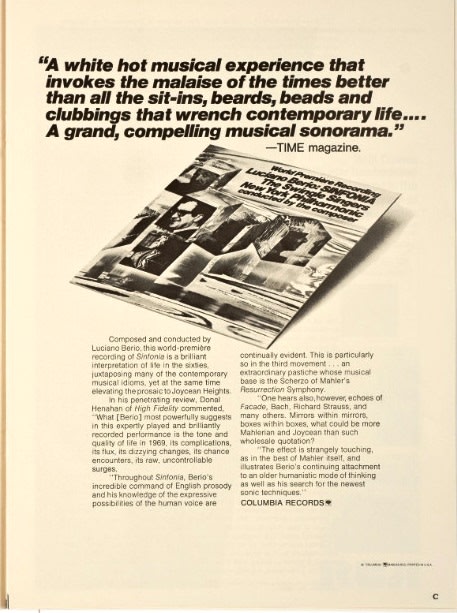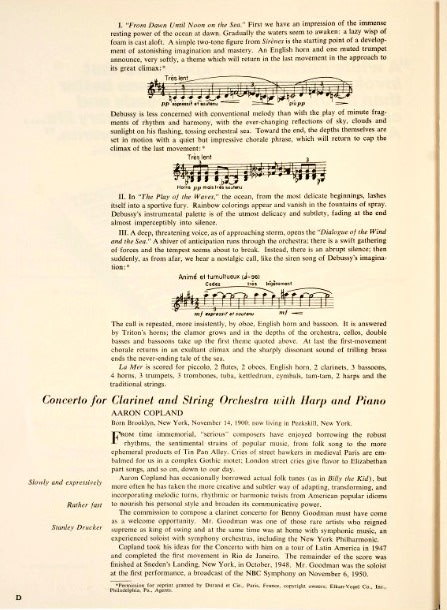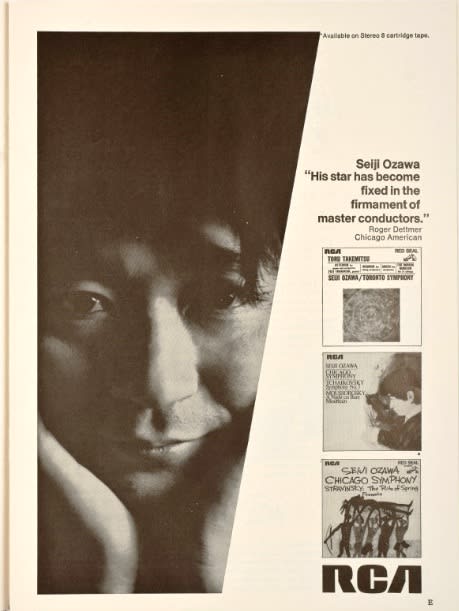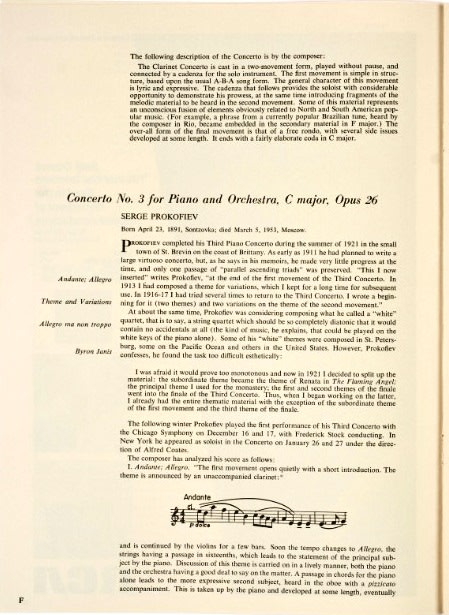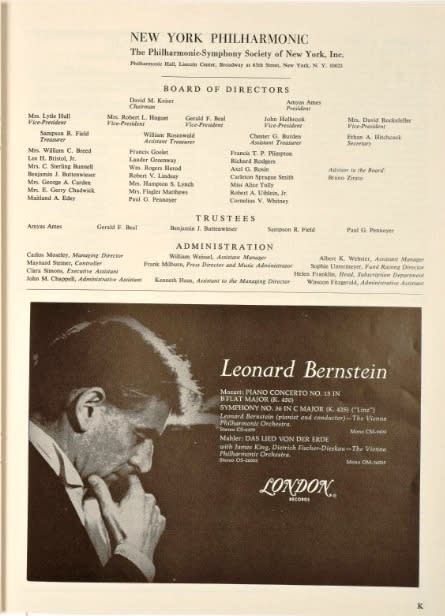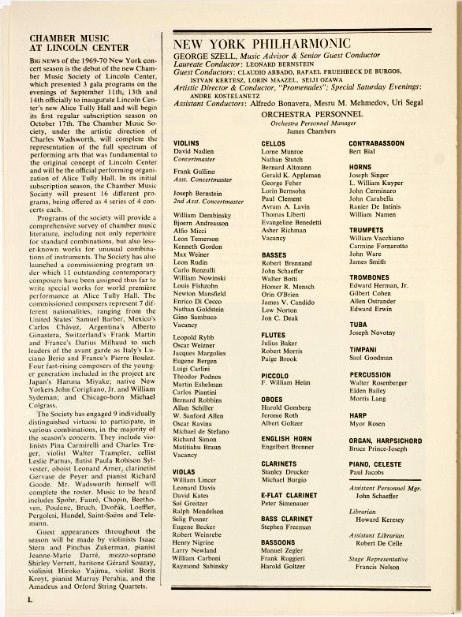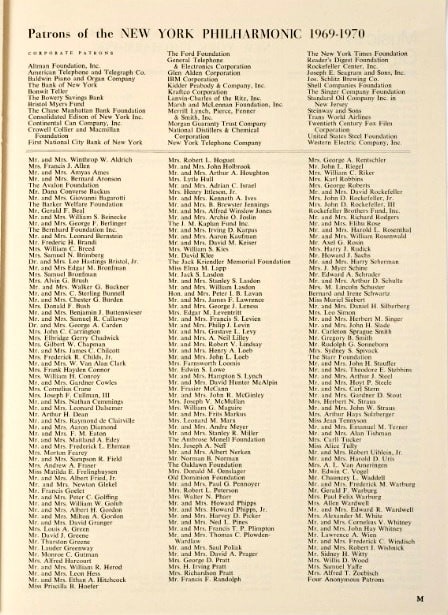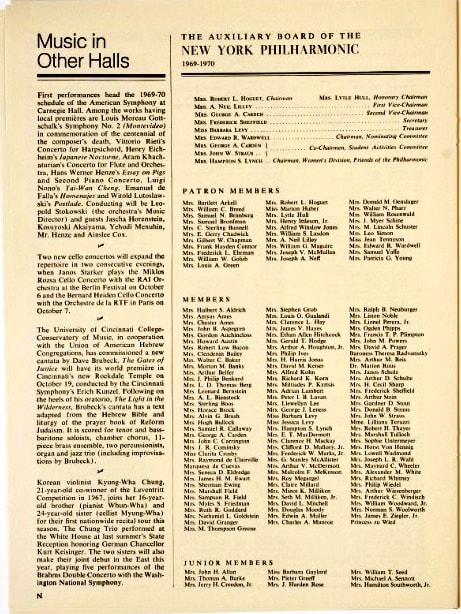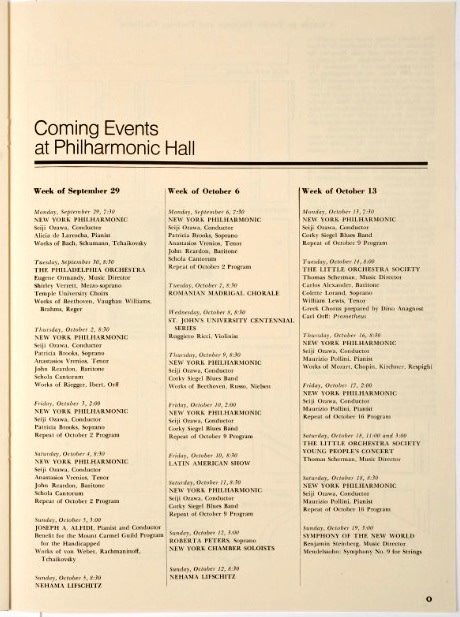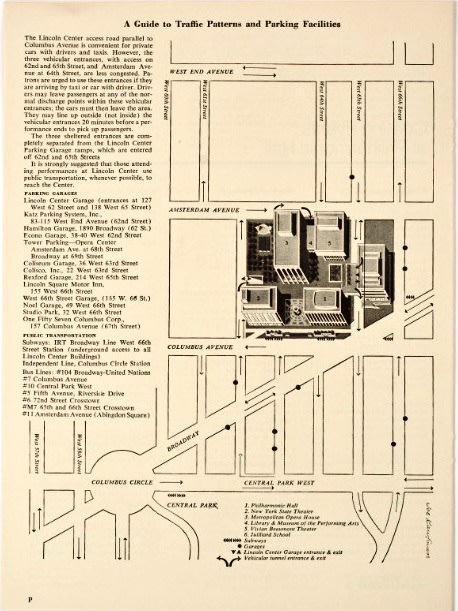ニューヨーク・フィルハーモニック1969-1970シーズン、オープニング・ガラコンの指揮者は小沢征爾で、ソリストはバイロン・ジャニスとスタンリー・ドラッカーだった1969.9.23
小沢征爾はボストン、ヨーロッパの大活躍の前に、既にニューヨーク・フィルハーモニックを征服していた。
小沢征爾&NYPのコンサート一覧。
2305- 小澤征爾ニューヨーク・フィル公演一覧
1961年3月に副指揮者になってから何度も振っているが、ついにその時が来た!オープニングを振るというその時が!
(日本のオケだとシーズン初日とかいっても、モソッとはじまっていてイヴェントでもなんでもない、一流どころの指揮者はシーズン初めでバッティングしていて来日の優先度は低く、かといって国内の指揮者で華やか系実力系盛り上げ系というのもいなくて本当にモソッとはじまる。日本で、シーズン初日うきうきしたためしがない。一応節目ではあると思うのだが。
●
それで、このシーズン初日のプログラム。
NYP128シーズン目、1969-1970シーズン
NYP通算7708回目のコンサート
1969年9月23日(火)8:30pm
フィルハーモニック・ホール
≪ゲイラ・オープニング・ナイト・ベネフィット・コンサート≫
ドビュッシー 海
コープランド クラリネット協奏曲
クラリネット、スタンリー・ドラッカー
プロコフィエフ ピアノ協奏曲第3番
ピアノ、バイロン・ジャニス
プロコフィエフ ロメオとジュリエットより4曲
小沢征爾 指揮 ニューヨーク・フィルハーモニック
このときのメンバー表
デイヴィット・ナディエン、(ケネス・ゴードンもいますね)、ウィリアム・リンサー、ローン・マンロー、ジョン・シェーファー、ジュリアス・ベイカー、ロバート・モリス、ペイジ・ブルック、ハロルド・ゴンバーク、スタンリー・ドラッカー、ジョゼフ・シンガー、ウィリアム・バッキアーノ、・・・・mmmm唖然
有名どころがゴロゴロころがってます。すごい。
1961年からNYPを散発的に振っているとはいえ、このオープニング・ナイト、メンバー表見るだけでクラクラします。これを小沢征爾は颯爽と振ったわけです。アンビリーバブル!
プログラム全ページ
●
辛口評論家ハロルド・ショーンバークは翌日、さっそく感想を投稿しております。
この人は、毎度、難解(と思う)な言いまわしや単語が目白押しで、口の辛さ、頭の固さ、一人で双璧ではないでしょうか。

翻訳用打ち込み版(文字にファンブルあるかもしれません)
New Philharmonic Sound Grows
By HAROLD C.SCHONBERG
Exactly seven years after the day of its opening, the new Philharmonic Hall was unveiled last night, It has a new look, a new sound, and there was a feeling of success in the air. Philharmonic Hall from now on is going on to be a happy auditorium, rather than one staggering under the stigma of acoustic failure.
The feeling ran especially high at yesterday morning’s rehearsal by the New York Philharmonic. It started at 11. Two hours later everybody was slapping everybody else’s back. The consensus was that the acoustic jinx had been more than licked. It had been squashed flat, demolished, exorcised.
The musicians of the orchestra were especially happy. For seven years they had been complaining that they could not hear one another on stage.
“Now,” said Walter Rosenberger, the percussionist, “we can do ensemble playing. We can pay attention to the differences between forte and mezzoforte.”
The conductor, Seiji Ozawa, had a typical conductor’s comment.
“The musicians can hear me much better now. That is a good sign.”
There were those yesterday morning, however, who suspended judgment, knowing that there is quite a difference between sound in an empty hall and sound in a packed auditorium. Heinrich Keilholz, the acoustician, said that the characteristics would better when the house was full. Others pointed out that people soak up sound, and that the characteristics would then be different.
As things turned out, there was a decided difference last evening. At the morning rehearsal the strings sounded full and rich, blending well with the other choirs of the orchestra. Bass instruments sounded much more natural than they ever had done in Philharmonic Hall, and there was considerably more warmth and presence.
But at the evening concert the audience did indeed soak up sound, especially bass sound. There was still a much finer bass than the hall has had up to now., and the violins sounded silken. Definition, which always had been superior, was better than before. Completely gone were the annoying echo and the rather shrill hi-fi kind of sound. The piano, as played by Byron Janis in the Prokofiev Third Concerto, came through clearly and firmly.
In the top balcony, the orchestral sound was exceptionally impressive. There was, as before, a falling off in the loges under the overhangs. Little can be done about the aside from repealing some of the laws of nature. Sound gets trapped in those spaces.
.
Acoustician Dismissed
On the orchestra floor the listening was easy. The only missing element was the morning rehearsal had shown, and that can be attributed to the slight lack of bass. Presumably that can be relatively simple to correct. On the whole, there has been a startling improvement in Philharmonic Hall acoustics, and it will bear fruit in happier musicmaking.
The undertaking was a considerable gamble on the part on the orchestra. When Philharmonic Hall opened on Sept 23, 1962, it proved to be an acoustic catastrophe. After the first shock of horror wore off, the acoustician, Leo Beranek of Bolt, Beranek & Newman was dismissed. Mr. Beranek, acknowledging that the hall had problems, has since insisted that he could have solved everything had he been given a chance. Mr.Keilholz, from Germany was brought in as the new acoustician.
He proposed several stages of acoustic redemption. The final stage took place last summer.
Between June 15 and Sept 15, the hall was closed for extensive alterations, including removal of the original acoustic “clouds” and the substitution of a solid ceiling.
Yesterday morning’s rehearsal brought in the Philharmonic for concert that was to take place that very evening. Not a note of music had been heard there except for a tryout Monday night by the pianist Alicia de Larrocha. It was an all-or-nothing occasion. No technicians had been running around firing cannons or testing with oscillators. Nobody had the least idea of how the hall was going to sound.
Thus, as the Philharmonic filed on stage, there were very scared faces in the tiny audience. The two most directly involved were Mr. Keilholz and Amyas Ames, president of the Philharmonic. Mr. Ames was gambling $2-million on Mr. Keilholz’s talents as an acoustician. The current renovation cost $1.3-million and previous stages $700,000.
The gamble appears to have succeeded. And it was a gamble with an acoustician who looks back rather than forward. As an acoustician Mr. Keilholz is a traditionalist. He believes in wood and plaster, especially wood. Several years ago he inserted curved wooden moldings around the sides of the hall to break up and diffuse the sound. This time he has created a stepped-up ceiling, stage built a wooden platform for the cello section and changed the material of the seats.
The hall has a new color scheme. The ceiling is off-white. The diffused lighting by Abe Feder is brighter but with less glare. All of the wooden side panels have been bleached back to the original unpainted color. One result is that the hall looks wider than it previously had appeared. The effect is psycho-visual, but it is there.
Mr.Keilholz yesterday attributed the acoustic improvement primarily to the new ceiling. The previous acoustic clouds trapped the low frequencies. Now they can reverberate freely. Sound is also transmitted directly to the stage. To the Philharmonic musicians, this is by far the most important change of all.
Philharmonic Hall now will be able to hold its head up. Audio comfort rather than audio fatigue can be experienced within its walls. And at least one listener is no longer automatically going to shrink into his seat, waiting for the echo when the snare drum starts to roll or the trumpeter brings the mouthpiece was none of that, and it is a good description of happiness.
フィルハーモニック・ホールの音質改善がされたあとの最初の日の公演であったため、ホールの音響のことが大半を占めた文になっております。
本文全文を読まれる方は下記の河童注を先に読めば事情が多少わかります。
河童注:
NYPの本拠地はカーネギーホールだったのですが、1962年9月から再開発地帯のリンカンセンターのフィルハーモニック・ホールに移りました。ただ、音響が良くなくアコースティックの改善をおこなった。その初日の公演が、小澤征爾によるこの日のオープニング・ゲイラだったので、辛口男ショーンバークは演奏評もそこそこにアコースティックの記事がメインとなっているようです。
これは1969年時点の話であり、1973年に莫大な寄付をした人物の名前にちなんでエイヴリー・フィッシャー・ホールと名前を変え、その後もたびたび音響改善工事を何度か(何度も)おこなっている。
57丁目の角にあるカーネギーホールは、地下鉄の通過音とか聞こえてくるホールだったのですが、演奏の響きは引き締まって、かつ潤いもあり数年前に、本拠地をカーネギーホールに戻そうかといった話もでました。結局それもならず、エイヴリー・フィッシャー・ホールで行っているわけです。そして今は、ディヴィッド・ゲフィン・ホールと名前を変えましたね。
国で一番(かどうかはあるが)のオーケストラのホールの音響がダメモードというのは日本でもある話ですね。
注おわり
小澤はボストンやヨーロッパの活躍の前に、ニューヨーク・フィルとの偉大な歴史がありました。
若いときの小澤征爾の活躍は尋常ではなかったと。
1971年2月22日の演奏会のあとは今のところないのだが、とにかくその1971年までに小澤はニューヨーク・フィルの歴史を作ってしまっていたのだ!アンビリーバブル。
さらにアンビリーバブルなのが、ソリスト。今こうしてあらためて見てみると「すごい」。
1961年から振りはじめ、最初の頃はバーンスタインや他の指揮者と一晩を振り分けていた時期もあるが、時がたつにつれ沸騰していき、ついに1969年9月23日にはシーズン・オープニングのポーディアムに立った。
















